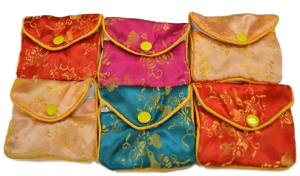 One of the most frequent questions you will get from clients is how to store jewelry. Here are some do’s and don’ts for metals and for beaded jewelry plus I’ve allowed myself to indulge in a short rant.
One of the most frequent questions you will get from clients is how to store jewelry. Here are some do’s and don’ts for metals and for beaded jewelry plus I’ve allowed myself to indulge in a short rant.
One of the most irritating products I see are those necklace trees where jewelry, especially necklaces, are hung.
Well-meaning people on pinterest and other sites post “cute” or “creative” ways of hanging jewelry by using towel racks, nails in picture frames or closet hangers, etc., etc.
Avoid these. Don’t use them yourself and never recommend them to your clients. Creativity should be used for other, more productive, projects. Hanging jewelry is not the way to go for either beaded jewelry or metal jewelry.
The one exception to this is of course sculptural jewelry, that is, jewelry that is made to be shown, not worn.
The reason these trees, whether commercial or individually constructed, should be avoided is that they shorten the life of beaded jewelry and encourage tarnish on metal jewelry. So, on the one hand, they shorten the manufacturing life of beaded jewelry while on the other hand they create polishing work on metal jewelry. Why on earth would anyone bother with this?
As you know, thread is a primary manufacturing element in beaded necklaces. One of the primary objectives of a professional pearl and bead stringer is to manufacture jewelry that will last as long as possible which is why we devote such attention to thread choices versus design decisions. But, ultimately, all thread stretches. It just does. Thread also gets dirty.
If you hang a beaded necklace on one of the trees, the weight of the necklace will pull and stretch the thread and the knots between the beads. Obviously, this damages the jewelry.
Just don’t do it and never recommend it. Again, save the creativity for something more productive.
Jewelry Trees and Metal Jewelry
I have a similar objection to using those trees for metal jewelry. With very few exceptions, metals tarnish when exposed to air. This is called oxidation and is particularly acute in polished silver jewelry. However, it also occurs in jewelry where a thin layer of gold is fused to sterling. (Many jewelers are using these metals today as the cost of gold remains so high.)
Pure gold (24k) does not tarnish, that is, it doesn’t react to air. But most gold is alloyed, that is, it contains other kinds of metals, coppers, silvers, etc., and these metals tarnish.
So by hanging metal jewelry on jewelry trees, a client is creating polishing work for herself. Advise against it.
Store Jewelry Flat and Store Pieces Separately
The best way to store jewelry is to store each piece in its own silk pouch. The most common ones and the ones I like the best are from China. You see them at all the gem shows and jewelry supply companies; they’re very inexpensive and are available in a variety of sizes.
In addition, gem show vendors will frequently show unusual silk pouches that are quite lovely, so keep your eyes open for these.
When I ran the gallery, I always had a supply of gorgeous silk pouches and one accompanied every sale. Clients really appreciated them and they were a signal to clients of the value I placed on the jewelry I sold.
Metal and beaded jewelry should be stored separately in silk pouches like those pictured above. The key concern for beaded jewelry is to protect the thread; the key concern for metal jewelry is that you don’t want metals rubbing against each other and scratching polished surfaces.
In addition, metals that tarnish easily should be stored in zip locked plastic bags to minimize oxidation. For clients, put the piece of jewelry in a zip lock bag and insert that into a silk pouch. Then tell them why you’ve done it.
Most serious jewelry collectors know not to use these jewelry trees, but they can be tempting and you’ll occasionally get a question about one from this group. Young collectors, however, may not have considered the harm the trees can do, so be prepared to give them good advice. They’ll thank you for it.

